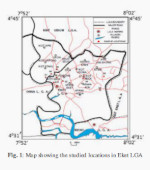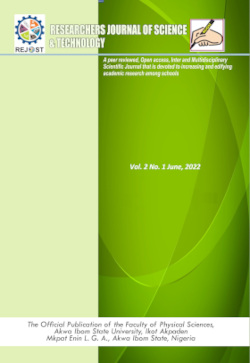Assessment of the Quality of water samples from Private Boreholes in Eket Local Government Area, Akwa Ibom State, Nigeria
Keywords:
Water Quality Index, Pollution Index, Boreholes, Potable Water, AquiferAbstract
The major source of drinking water in our local communities is private boreholes, in which the quality of water becomes a public health concern.In an attempt to ascertain the health risk that thepeople are exposed to, this study was conducted to assess the quality of water from private boreholes in Eket Local Government Area. Water samples from the boreholes were subjected to analyses forphysico-chemical characteristics. For this purpose, water samples were collected from ten private boreholes for analyses and compared with the World Health Organization (WHO) permissible guidelines for potable water. Some of the parameters analyzed for by the standard test methods for the examination of water and wastewater were: pH, conductivity, dissolved oxygen, redox potentials, nutrients, trace metals, iron, total hardness, calcium, magnesium, total alkalinity, bicarbonate alkalinity, carbonate, hydroxide and alkalinity. pH values of the water samples gave values that were below the permissible range of 6.5 to 8.5 for potable water, whereas, values for dissolved oxygen, redox potential, total dissolved solids, total hardness, calcium content, magnesium content, sulphate, phosphate, nitrate and sulphide were below the permissible limits for potable water. Alkalinity determination indicated that the water samples from boreholes have predominantly bicarbonate alkalinity, with negligible carbonate and hydroxide alkalinity. Though, the total alkalinity was below the permissible limit, the water samples are likely to form scales in boilers and heaters. The total hardness of the considered samples indicated the hardness classification range of 17.5 g/l to 59.5 mg/l, which is slightly hard and may require minor treatment for drinking and other domestic purposes. Notwithstanding the fact that the exploited aquifer in Eket has shallow depths of between 16.0 m to 30.4 m, values for lead, cadmium, copper, zinc, iron and manganese were below the permissible limits, except in station 1, in which the water has enhanced iron content above the permissible limit of 0.3 mg/l. The water samples had mean salinity of 0.01 %, indicating that there is no salt water intrusion even though Eket is a coastal area. The mean pollution index calculated for all the sample parameters gave values that were below the critical value of one, indicating no contamination of the aquifer by anthropogenic activities.
References
Adekola, Olalekan; Abubakar Bashir, and Abdulul-mumini Kasimu. Physiochemical characteristics of borehole water qualitinGassol Taraba State, Nigeria. African Journal of environmental science and technology.9 (2) 143-154. 2015.
Akankpo A.O; Igbokwe M. U. Monitoring Ground-water contamination using surface electrical resistivity and
geochemical methods. Journals of water resources prof. 3 (5); 318-324. 2011.
Akpofure R. R., Khifa G. O., Okorkoyo P. A. Physicochemical characteristics of some waters used for drinking and
domestic purpose in the Niger Delta, Nigeria. Environmental monitoring and assessment, 128 (1-3), 475 – 482,
Akpokodje, E.U; Etu-Efatebor J. O. The occurrence and economic pontential of clean of Delta. J. Afric. Earth Sci. 6(1),
-65, 1987.
Akpoveta O.V; Okoh B.E, and Osakwe S.A. Quality assessment of borehole water used in the vicinities of Benin, Edo
State, of Nigeria. Current research in chemistry 3, 62-69, 2011.
Anawara, H.M., J. Akaib, K.M.G. Mostofac, S. Safiullahd and S.M. Tareqd. Arsenic poisoning in groundwater health risk
and geochemical sources in Bangladesh. Environ. Int., 27: 597-604. 2002.
APHA, AWWA, WEF. Standard Methods for the Examination of Water and Waste Waters. 21st Edition. American
Public Health Association. USA. 2005.
Asonye, c. c Okolie N. P, Okenwa, E. E; Iwuanyawu U. G. Some physio -chemical characteristics and heavy
metals profile of Nigerian rivers, streams and wetlands, Afric. Jour. Biotechnol. 6 (5) 617-624, 2000.
Atakpo E.. Delineation of underlying aquifer formation in the oil producing community of Uzere, Isoko south L. G.
A, Delta state; Nigeria. J.Science Environ. 8. 121-131. 2009.
Baswinkel K. A. Information Note. International ground water resources Assessment Center (IGRAC)
Netherlands Institute of Applied Geosciences. Netherlands. (2000).
Batmanghellij F., Paje M. J. Your body’s Mary Cries for water Tantor incorporated. 2012.
Bellisie F, Thoruton S. N., Hebel P, deniseau M. Tahiri M A study of fluid intake from beverages in a sample of health
French children, adolescents and adults. Eur. J. Clini. Nutri 64(4), 350-355. 2010.
Bhattachanya P., Chatterjee D, Jacks G.. Occurrence of Arsenic Contaminated ground Water in Alluvial Aquifers
from Delta Plains, Eastera India; options for Safe drinking water supply. International journal of water resources development. 13(1), 79-92, 1997.
Capenter S.R.; Caraco N.F.; Correll D.L. Howarth R.W.; Sharpley A.N.; Smith V.H. Nonpoint Pollution of Surface
Waters with Phosphorus and Nitrogen. Ecological applications 8(3), 559 –568, 1998.
Chigor V.N.; Umoh V.J; Okuofu C. A.;Ameh, J.B; Igbinosa, E.O; Okoh, A.I. Water Quality Assessment: Surface, Water Sources used for drinking and irrigation in Zaria, Nigeria are a public health hazard. Environmental monitoring and
assessment. 184(5): 3389 – 3400, 2012.
Chilton, J. Groundwater, Water Quality Assessments – A Guide to Use of’ Biota, Sediments and Water in Environmental Monitoring Second Edition 10, 1996.Dahunsi SO,
Owamah HI, Ayandiran TA, O ranusi SU (2014). Drinking Water Quality and Public Health of selected Towns in South western Nigeria. Water Quality Exposure and Health.
Etesin Usoro; Enewan Udoinyang; Thomas Harry. Seasonal variation of physicochemical parameters of water
and sediments from Iko River, Nigeria Journal of Environment and Earth Science. 3 (8). 96-110, (2013).
Fournier, R, Tuesdell, A. An empirical Na, K, Ca geothermometer for Natural Waters. Geochimica et Cosmochimica
Acta 37 (5) 1255-1275. 1973.
Gundry, S.; Conroy R.; Wright J. A Systematic Review of the health outcomes related to household water quality in developing countries. J.Water Health. 2. 1-13. 2003.
Ikem, A, Odueyungbo, S.. Egiebor, N.O. Nyavor, K Chemical Quality of Bottled Waters from Three Cities in Eastern
Alabama, Science of the Total Environment. 285 (1). 165-175. 2002.
Iowa Department of Natural Resources. Iowa’s Water – Ambient Monitoring Program. Water Fact Sheet 2004 - 4. p.
(2004).Kot, B., Baranowski R and Rybak A. Analysis of Mine Waters using X-ray flworescence spectionetry Polish J.
Environ Stud. 9: 429-432, 2000.
Liu, A., J. Ming and R. Ankumah. Nitrate Contamination in Private Wells in Rural Alabama, United States. Science
of the Total Environment 346 (1-3): pp.112-120. 2005.
Lindsey, B.D; J.S. Rasberry and T.M. Zimmerman. Microbiological quality of water from non-community supply
wells in carbonate and crystalline Aquifers of Pennsylvania; U.S Geological survey. Water Resources Investigations Report 01-4268 (2002).
Mack, G.W.and Nadel, E. R. Body Fluid Balance During Heat Stressin Humans. Comprehensive Physiology. 2011.
Offei-Ansah C.. Food habits and preferences as a factor as a factor in the choice of meals by students in the university of
Cape Coast. Nutrition and Health 21(3), 151-172. 2012.
Magnus Uzoma Igboekwe, Efurumibe Ezinna Lucky and Akaninyene Okon Akankpo). Determination of aquifer
characteristics in Eket, Akwa Ibom State, Nigeria, using the vertical electrical sounding method. International journal of water resources and engineering. 4(1), 1-7,(2012).
Mbonu PDC, Ebeniro JO. Geoelectric Sounding for the Determination of Aquifer Characteristics in Parts of Umuahia Area of Nigeria. Geophys., 56: 284-291. 1991.
Ncube E.J., Schutte C.F. The occurrence of Flouride in South Africa ground water: A water quality and health problem.
Water S. A. 31(1) 35-40, 2005.
New Jersey Department of Environmental Protection. Private well testing Act program: Initial Results for September
to March 2003.
Division of Science, Research and Technology, and Water Supply Administration, Bureau of Safe Drinking Water: p. 65. 2004.
Okolie, E.C; Osemeikheian, JEA; Asokhia, M. B. Estimate of Ground Water in Parts of Niger Delta Area of Nigeria
using Geoelectric Method. Jour. Of Applied Sci. Environ. Manage. 9 (1). 31-37. 2005.
Okolie, E. C. Geoelectric Investigation of the Effects of Heavy Clay Deposits on Aquifer Potentials in Okpala Water
side, Delta State, Nigeria. Jour. Geol. Min.Res. 3 (2), 39-45. 2011.
Okorafor KA, Agbo BE, Johnson AM, Chiorhe M. Physicochemical and bacteriological characteristics of selected steams andborehole in Akankpa and Calabar municipality, Nigeria. Arch ApplSci Res 4 (5): 2115-2121. 2012.
Okwueze, E. E, Preliminary findings of the ground water resources potential from a regional geoelectric survey of the
Obudu Basement Area, Nigeria. Global J. pure and applied Sci 2 (2) 203-211. 1996.
Owamah HI, Asiagwu AK, Egboh SHO, Phil-Usiayo S. (2013). Drinkingwater quality at Isoko North communities of
the Niger DeltaRegion, Nigeria. Toxicol Environ Chem.
Quagraine, E.K. and C.K. Adokoh. Assessment of dry season surface, ground and treated water quality in the cape coast municipality of Ghana. Environ. Monit. Assess., 160: 521-539.2011
Rowe, B.L., P.L. Toccalino, M.J. Moran, J.S. Zogorski and C.V. Price. Occurrence and Potential Human-Health. (2007).
Shryer D.. Body fuel: A guide to good nutrition, Marshall Cavendish. 2007.
WHO. (2008). Safer water, Better Health: Costs, benefits and sustainability of interventions to protect and promote
health genera, Switzerland world health organization.
Singh, S. and L.M. Mosley,. Trace metal levels in drinking water on Viti Levu, Fiji Islands. S. Pac.J.Nat.Sci., 21: 31-34, 2003.
Sunnudo-Wilhelmy, S.A. and G.A. Gill,. Impact of the clean water Act on the levels of Toxic Metals in Urban Estuaries the Hundson River Estuary Revisited. Environ. Sci. Technol., 33: 3471-3481. 1999.
Standards of Nigeria. Nigerian Standard for Drinking Water Quality. Lagos. Nigeria. 2007. Swistock, B. R. and W. E. Sharpe. The Influence of Well Construction on Bacterial Contamination of Private Water Wells in Pennsylvania. Journal
of Environmental Health 68 (2), 17-23. (2005).
Swistock, B.R; W.E. Sharpe and P.D. Robillard. The Influence of Well Construction on Bacterial Contamination. The Centre for Rural Pennsylvania. May 2004 The United Nations Children’s Fund. (2010).
Diarrhoea. Why Children are still Dying and What can bedone. www.unicef.org/media/fiels/final-diarrhoea
Udom, G.J., F.A. Ushie and E.O. Esu,. A geochemical survey of groundwater in Khana and Gokana local government
areaof Rivers State, Nigeria. J. Applied Sci. Environ. Manage., 6: 53-59. 2002.
USEPA,1986 .Method by method statistics from Water Pollution (WP) laboratory performance evaluation studies.
Quality Assurance Branch, Environmental Monitoring and Support Lab., Cincinnati, Ohio.
Uzomah Vic; Scholz M. Water Availability Assessment and Corresponding Public Health Implication for a Rural Area in
Nigeria. Water and Environment Journal 16(4), 296-299. (2002).
Voices Almost Half of Nigeria’s population can’t access clean water, Abuja, Nigeria. 2013.
WHO (2006). Meeting the MDG Drinking Water and Sanitation Target: The Urban and Rural Challenge of the decade Genera, Switzerland, World Health Organization.
World Health Organization. Guidelines for drinking water standard incorporating 1st and 2nd addendum. 2008.WHO. (2011).
Guideliness for Drinkingwater quality. Geneva, Switzerland. World Health Organization. 2011.
Dept for Environment, Food and Rural Affairs. The Environment Agency. Assessment of Risks to Human Health
from Land Contamination. An Overview of the Development of of Soil Guideline Values and Related Research. Bristol, United Kingdom Environment Agency.
Young, J.C., G.N. McDermott and D. Jenkins,. Alterations in the BOD procedure for the 15th edition of standard methods for the examination of water and wastewater. J. Water Pollut. Control Fed., 53: 1253-1253.1981.
Zimmerman, T.M., M.L. Zimmerman and B.D. Lindsey. Relation Between WellConstruction Practices and Occurrence of Bacteria in Private Household-Supply Wells, South-Central and Southeastern Pennsylvania. U.S. Geological Survey
Water-Resources Investigations Report 01-4206.

Downloads
Published
How to Cite
Issue
Section
Categories
License

This work is licensed under a Creative Commons Attribution-NonCommercial-NoDerivatives 4.0 International License.




